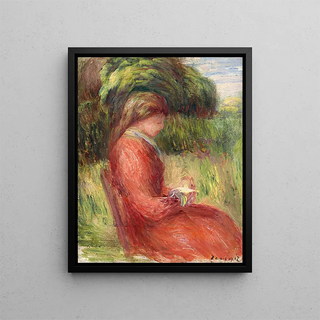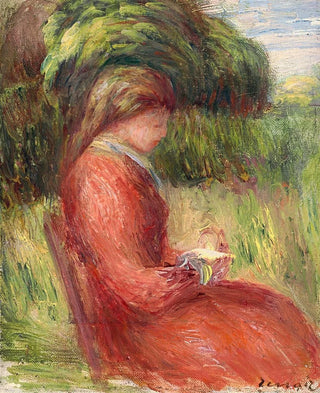Art print | Young seated woman - Pierre-Auguste Renoir


View from behind

Frame (optional)
In the vast panorama of Impressionism, "Young Woman Sitting" by Pierre-Auguste Renoir stands out for its delicacy and its ability to capture the very essence of feminine beauty. This artwork, created in 1876, witnesses a suspended moment where time seems to stand still to admire the grace of a young woman lost in her thoughts. The painting invites the viewer to come closer, to feel the intimacy of the scene, and to wonder about the thoughts crossing this muse's mind. The soft light, warm colors, and natural pose of the main figure create a serene and contemplative atmosphere, making this piece a true masterpiece of modern art.
Style and uniqueness of the work
Renoir's style is characterized by an innovative approach to color and light. In "Young Woman Sitting," fluid brushstrokes and delicate nuances blend to give life to the young woman's skin, which seems to almost vibrate under the rays of the sun. Shadows are subtly suggested, and the ambient luminosity envelops the figure with an almost ethereal aura. Renoir excels at rendering the texture of fabrics, hair, and even natural elements surrounding her. The composition, though simple, is highly effective: the woman, slightly profile, engages the viewer's gaze while maintaining a posture of tranquility. This blend of spontaneity and technical mastery makes this artwork a perfect illustration of Impressionist spirit.
The artist and his influence
Pierre-Auguste Renoir, one of the founders of the Impressionist movement, knew how to mark his era with a unique artistic vision. His work, often focused on the human figure and scenes of everyday life, paved the way for a new way of perceiving painting. Renoir always sought to capture the joy of living, and "Young Woman Sitting" is a shining example. His influence extends far beyond his time, inspiring many artists who followed in his footsteps, while continuing to resonate with his legacy. The gaze cast on beauty, light, and color that he

Matte finish

View from behind

Frame (optional)
In the vast panorama of Impressionism, "Young Woman Sitting" by Pierre-Auguste Renoir stands out for its delicacy and its ability to capture the very essence of feminine beauty. This artwork, created in 1876, witnesses a suspended moment where time seems to stand still to admire the grace of a young woman lost in her thoughts. The painting invites the viewer to come closer, to feel the intimacy of the scene, and to wonder about the thoughts crossing this muse's mind. The soft light, warm colors, and natural pose of the main figure create a serene and contemplative atmosphere, making this piece a true masterpiece of modern art.
Style and uniqueness of the work
Renoir's style is characterized by an innovative approach to color and light. In "Young Woman Sitting," fluid brushstrokes and delicate nuances blend to give life to the young woman's skin, which seems to almost vibrate under the rays of the sun. Shadows are subtly suggested, and the ambient luminosity envelops the figure with an almost ethereal aura. Renoir excels at rendering the texture of fabrics, hair, and even natural elements surrounding her. The composition, though simple, is highly effective: the woman, slightly profile, engages the viewer's gaze while maintaining a posture of tranquility. This blend of spontaneity and technical mastery makes this artwork a perfect illustration of Impressionist spirit.
The artist and his influence
Pierre-Auguste Renoir, one of the founders of the Impressionist movement, knew how to mark his era with a unique artistic vision. His work, often focused on the human figure and scenes of everyday life, paved the way for a new way of perceiving painting. Renoir always sought to capture the joy of living, and "Young Woman Sitting" is a shining example. His influence extends far beyond his time, inspiring many artists who followed in his footsteps, while continuing to resonate with his legacy. The gaze cast on beauty, light, and color that he






